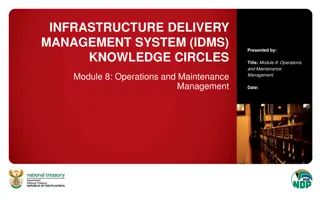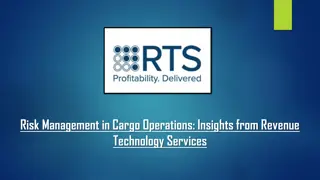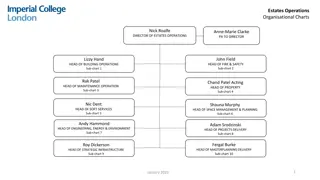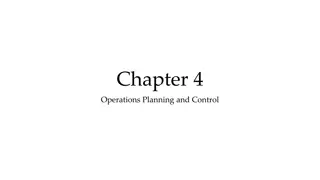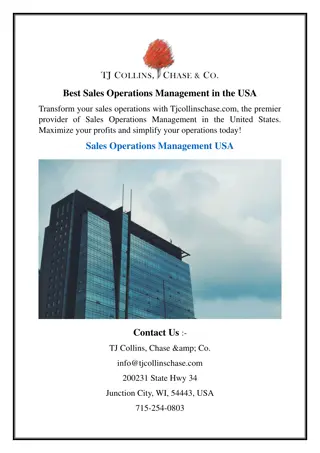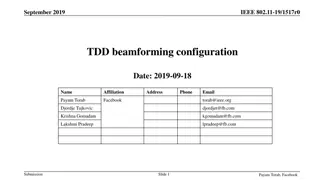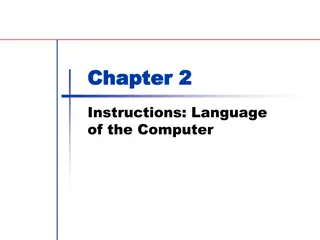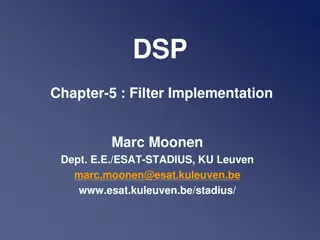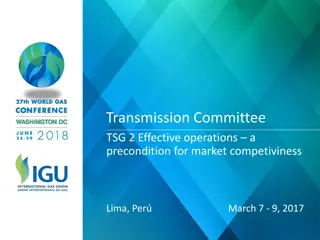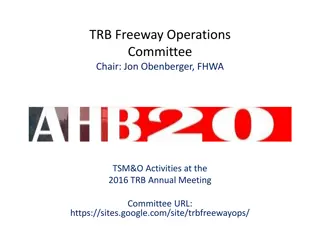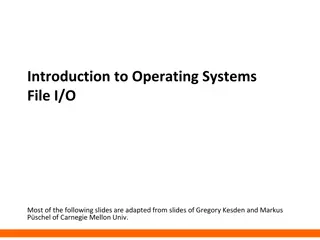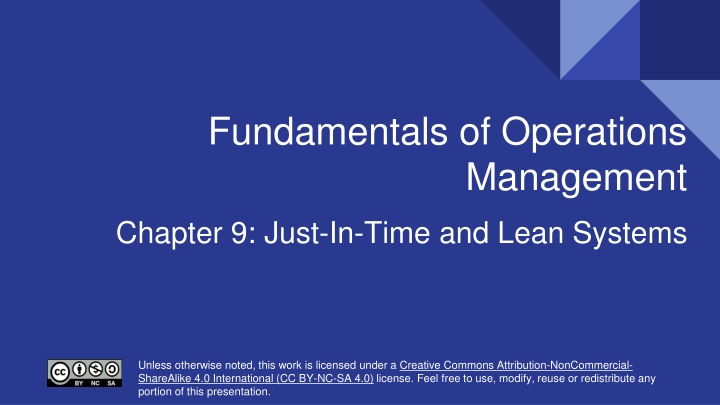
Just-In-Time and Lean Manufacturing Concepts
Explore the fundamental principles of Just-In-Time (JIT) and lean manufacturing, how they eliminate waste, improve efficiency, and optimize operations. Learn about JIT systems, lean control, and the core objectives of lean manufacturing.
Download Presentation

Please find below an Image/Link to download the presentation.
The content on the website is provided AS IS for your information and personal use only. It may not be sold, licensed, or shared on other websites without obtaining consent from the author. If you encounter any issues during the download, it is possible that the publisher has removed the file from their server.
You are allowed to download the files provided on this website for personal or commercial use, subject to the condition that they are used lawfully. All files are the property of their respective owners.
The content on the website is provided AS IS for your information and personal use only. It may not be sold, licensed, or shared on other websites without obtaining consent from the author.
E N D
Presentation Transcript
Fundamentals of Operations Management Chapter 9: Just-In-Time and Lean Systems Creative Commons Attribution-NonCommercial-ShareAlike 4.0 International (CC BY-NC-SA 4.0) Creative Commons Attribution-NonCommercial-ShareAlike 4.0 International (CC BY-NC-SA 4.0) Unless otherwise noted, this work is licensed under a Creative Commons Attribution-NonCommercial- ShareAlike 4.0 International (CC BY-NC-SA 4.0) license. Feel free to use, modify, reuse or redistribute any portion of this presentation.
9.0 Learning Outcomes In this chapter, we will: Explain the fundamental principles of Just-In-Time (JIT) and lean manufacturing, identifying how these approaches aim to eliminate waste and improve efficiency in production processes. Describe the core objectives and principles of lean manufacturing, including the five core principles identified by James Womack and Daniel Jones, and apply these principles to analyze and improve manufacturing processes. Outline the key components and benefits of Just-In-Time (JIT) systems, including inventory reduction, pull production systems, quick setups, and flexible resources, and evaluate how these components contribute to operational efficiency and waste reduction.
9.1 Just-in-Time and Lean Manufacturing Concepts Just-in-Time (JIT) production focuses on meeting customer demand by producing goods only when needed, avoiding waste from overproduction or long delivery times. JIT is essential for maintaining quality and customer satisfaction, ensuring products like pizza are delivered fresh and on time. Lean manufacturing aims to eliminate waste in the production process, inspired by the Toyota Production System. Applying JIT and lean principles can optimize various operations, from simple tasks to complex manufacturing. This unit explores seven types of waste and methods for controlling them. Understanding JIT philosophy and pull systems can help organizations effectively manage inventory and improve efficiency.
9.2 Lean Manufacturing and Control Lean control aims to improve operational efficiencies and product quality by reducing waste through nonfinancial controls. Initially focused on manufacturing, lean methodologies now apply to various processes, including product development and order processing. Lean control techniques involve analyzing processes, identifying value-adding activities, and eliminating waste to enhance productivity and quality. The core principle of lean is to use fewer resources while maintaining or improving output levels, as popularized by the 1990 book "The Machine That Changed the World. Toyota's pioneering lean manufacturing principles, developed post-WWII, focus on resource-efficient production systems for diverse, low-volume outputs. Successful lean implementation requires managers to understand lean principles, choose appropriate lean tools, and adapt them to their business needs for maximum benefit.
9.3 Core Objectives and Principles of Lean Manufacturing Lean aims to eliminate muda (wasteful activities) in all business operations to enhance value and drive business success. Muda comprises seven deadly wastes, these include: Defects: Products failing to meet requirements create waste. Overproduction: Producing items before needed, leading to excess inventory. Transportation: Moving products without adding value. Waiting: Idle time due to undelivered goods or services. Inventory: Unused materials or goods tying up capital. Motion: Unnecessary worker or equipment movements. Over-processing: Using excessive resources or adding unneeded features.
9.3 The Five Core Principles of Lean Define Value from the Customer s Perspective: Describe the Value Stream for Each Product or Service: Produce at the Pace (Pull) of Actual Customer Demand: Strive for Continuous Improvement (Kaizen): Create Flow in Each Value Stream: Arrange activities sequentially to enable smooth and continuous flow, minimizing batch production. Continuously improve processes through regular kaizen events to achieve operational excellence. Identify and specify value based on the customer s needs and expectations for specific products or services. Map all activities involved in delivering a product or service to identify and eliminate waste. Align production with actual customer demand to reduce lead times and inventories.
9.4 Just-In-Time (JIT) Systems JIT Philosophy: JIT aims to eliminate non-value-added activities by producing only what is needed, when it is needed, in the exact quantity required. Inventory Reduction: Reducing inventory levels exposes waste and inefficiencies, prompting improvements in equipment, vendor quality, and processes. Pull Production System: Workflows are based on actual demand, reducing inventory and improving efficiency through tools like Kanban. Quick Setups: Reducing setup times and costs allows for smaller production runs, minimizing excess inventory and enhancing flexibility. Flexible Resources: General-purpose equipment and multifunctional workers adapt to changing circumstances, ensuring efficient production despite uncertainties. Cellular Layouts: Unidirectional product flows and multifunctional workers streamline processes, reduce lead times, and foster continuous improvement.
9.4 Total Quality Management Total Quality Management (TQM) goes hand in hand with the Just-In-Time (JIT) philosophy. Poor quality is a major source of uncertainty and non-value- added activities that disrupt JIT flow. TQM promotes continuous improvement, doing things right the first time, designing quality into products/processes, and focusing on prevention aligning with JIT s waste elimination goals. Integrating TQM principles into JIT environments mitigates quality-related disruptions, enabling more efficient JIT implementation. This synergistic approach enhances operational excellence and drives continuous improvement. Key synergies between TQM and JIT: Continuous improvement mindset Waste reduction through defect prevention Process optimization for smooth flow Employee empowerment and involvement Customer-centric focus on quality
9.4 Employee Empowerment Empowering front-line employees and fostering collaboration, accountability, and continuous improvement is crucial for JIT success, enhancing efficiency and employee engagement. Problem-solving teams: Employees collaborate to improve work processes. Empowerment to take action: Employees can swiftly correct problems. Quality responsibility: Employees ensure their work meets customer needs. Cross-functional skill sets: Employees can support various areas. Interconnectedness through demand- pull: Work is produced based on downstream needs. Coaching and facilitation: Management acts as coaches, not supervisors. Basic maintenance responsibilities: Employees maintain their machines.
Summary & Review Overview of JIT and Lean Manufacturing: Just-In-Time (JIT) and lean manufacturing focus on producing goods or services to meet customer demand precisely when needed, eliminating waste and enhancing efficiency. Toyota Production System: The Toyota Production System is a pioneering model in lean manufacturing, transforming production processes to minimize waste and optimize resource use. Seven Types of Waste: Lean manufacturing aims to eliminate seven types of waste: defects, overproduction, transportation, waiting, inventory, motion, and over-processing. Core Principles of Lean Manufacturing: The core principles include defining value from the customer s perspective, mapping the value stream, creating flow, producing at the pace of customer demand, and striving for continuous improvement (Kaizen). Lean Control Methodologies: Lean control methodologies enhance operational efficiencies and product quality through systematic waste elimination and process optimization. Key Elements of JIT Systems: JIT systems reduce inventory levels and lead times by producing only what is needed when it is required, utilizing pull production systems, quick setups, flexible resources, and cellular flow layouts, with Total Quality Management (TQM) integration for continuous improvement and employee empowerment.

